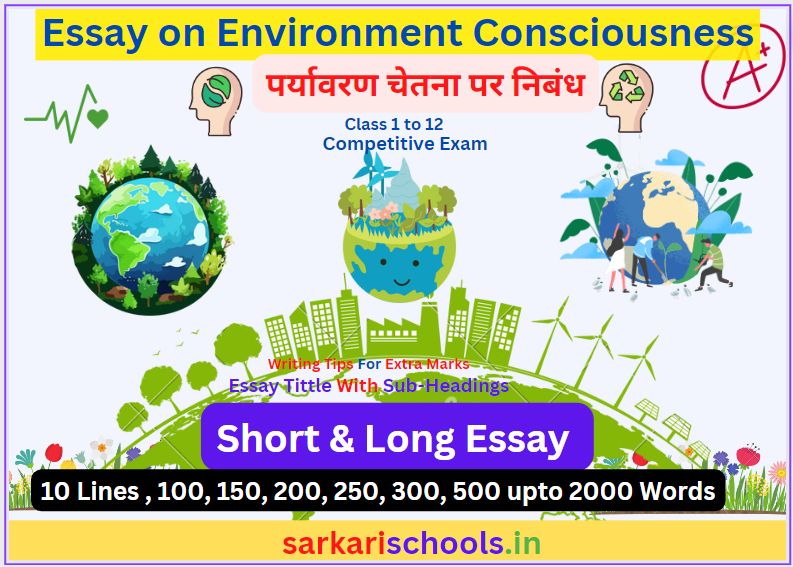Explore the importance of environment consciousness (Essay on Environment Consciousness) in today’s world through this insightful essay. Discover how understanding and caring for our environment can mitigate challenges like climate change, pollution, and biodiversity loss. Learn about the benefits of adopting eco-friendly practices and how individuals, businesses, and communities can promote a sustainable future. Overcome barriers and find inspiration to make a positive impact on our planet’s well-being. Read now for a comprehensive exploration of environment consciousness and its role in shaping a greener, healthier world.
Essay on Environment Consciousness

Cultivating Environment Consciousness: Nurturing a Sustainable Future
Essay on Environment Consciousness
Introduction:
Imagine a world where people care deeply about the environment, where they understand how their actions affect nature, and where they work together to protect our planet. This is what we mean by “environment consciousness.” It’s like having a special awareness about the world around us and realizing that we all have a responsibility to take care of it. In today’s world, this idea is more important than ever.
Right now, our planet is facing some big problems. These problems include things like climate change, pollution, cutting down too many trees (called deforestation), and animals and plants disappearing from the Earth (biodiversity loss). These issues might seem overwhelming, but by becoming more environmentally conscious, we can make a positive difference.
The reason why environment consciousness is so crucial is because it helps us protect not only the environment but also ourselves and future generations. We want the air we breathe to be clean, the water we drink to be safe, and the forests, oceans, and animals to thrive. By understanding and caring for the environment, we’re making sure that our planet remains a healthy and beautiful place to live, not just for us, but for our children and grandchildren too.
I. Understanding Environment Consciousness:
A. What Does Environment Consciousness Mean?
- Environment: The word “environment” comes from the Old French word “environer,” meaning “to encircle” or “surround.” This term evolved from the Latin “ambiens,” which also means “surrounding.” In the context of the natural world, “environment” refers to the surroundings or conditions in which living organisms exist.
- Consciousness: The term “consciousness” traces its roots to the Latin word “conscientia,” which means “knowledge within oneself” or “awareness.” It stems from “conscius,” meaning “knowing with” or “being privy to.” Over time, “consciousness” has come to denote the state of being aware, awake, and perceptive.
When combined, “environment consciousness” refers to a state of heightened awareness, understanding, and consideration of one’s surroundings and the impact of human actions on the natural world. It signifies a deep recognition of the interconnectedness between human activities and the health of the environment, often motivating individuals to adopt sustainable practices for the well-being of both ecosystems and future generations.
Environment consciousness is about knowing and caring about the big problems our planet faces. It includes understanding things like pollution, climate change, and how we use Earth’s resources. It’s like having a special “environment radar” that helps us make better choices.
B. Learning and Knowing:
Learning about the environment is really important. When we go to school, we can study things that help us understand how our actions affect the planet. Also, the things we see and hear in the news or on TV can shape how we think about the environment. Sometimes, people organize events or campaigns to tell everyone about these problems and how we can solve them.
II. Benefits of Environment Consciousness:
A. Saving Resources:
Our planet has limited resources like water, energy, and trees. If we use too much, there might not be enough left for the future. Environment consciousness helps us use resources wisely, so there’s enough for everyone.
B. Fighting Climate Change:
The Earth is getting warmer because of things people do, like burning fossil fuels (like coal and oil). This is called climate change, and it’s causing problems like extreme weather and rising sea levels. Being environmentally conscious means using cleaner sources of energy and making choices that reduce these problems.
C. Protecting Animals and Plants:
All living things are connected in a big web of life. When we harm one part of this web, it can affect everything else. Environment consciousness reminds us that we need to take care of animals and plants, so they can continue to live and thrive.
III. How Can We Care More About the Environment?
A. Small Actions Matter:
Even the things we do every day, like using less plastic or walking instead of driving, can add up to make a big difference. Each small action counts.
B. Companies and Governments:
Big companies and governments can also help by making eco-friendly products and passing laws to protect the environment. When they do this, it creates a better world for all of us.
C. Working Together:
When communities come together, amazing things can happen. Planting trees, cleaning up parks, and organizing events for a cleaner environment are great examples of how people can make a positive impact when they work together.
IV. Overcoming Challenges:
A. Money Matters:
Some people think that taking care of the environment is expensive. But in the long run, it can actually save money by preventing problems like pollution and resource shortages.
B. Different Cultures and Ways of Thinking:
People from different backgrounds might have different ideas about the environment. It’s important to understand and respect these differences while finding ways to protect the planet together.
C. Changing Our Habits:
Sometimes, it’s hard to change the way we do things. But by learning and practicing new habits, we can overcome these challenges and become more environmentally conscious.
Conclusion:
Being environment conscious means being a good friend to the Earth. It’s about understanding that we are all connected to nature and that our choices have an impact. By caring for the environment, we’re ensuring a healthier and happier world for ourselves and the generations that follow. Let’s remember that every small step we take, like recycling or using less electricity, adds up to create a big and positive change. Together, we can make a difference and create a more sustainable and beautiful future for our planet.
Essay on Environment Consciousness
Long Essay on Environment Consciousness
Essay on Environment Consciousness
Cultivating Environment Consciousness: Nurturing a Sustainable Future
Introduction:
In an era defined by mounting environmental challenges, the concept of environment consciousness has emerged as a guiding light, illuminating a path toward a sustainable and harmonious future. At its essence, environment consciousness entails a heightened awareness of our surroundings, an acknowledgment of the intricate interconnectedness of life on Earth, and a deep recognition of our responsibility as custodians of the planet. With issues like climate change, pollution, deforestation, and the alarming loss of biodiversity looming large, fostering environment consciousness has evolved from a mere aspiration to an urgent necessity. This essay embarks on a journey to explore the profound significance of environment consciousness, its manifold benefits, strategies for its promotion, and the potential hurdles that must be surmounted to secure the well-being of both present and future generations.
I. Understanding Environment Consciousness:
A. Definition and Components of Environment Consciousness:
At its core, environment consciousness embodies an acute awareness of pressing environmental issues that endanger the delicate balance of our ecosystems. It signifies a keen recognition of the far-reaching consequences of human actions on the natural world, coupled with a profound commitment to adopting sustainable practices that mitigate these adverse effects. This holistic approach challenges us to reevaluate our roles from passive inhabitants to active stewards, bound by the responsibility to protect and preserve our planet for generations to come.
B. The Role of Education and Awareness:
Education serves as a potent catalyst for nurturing environment consciousness. By integrating environmental education into school curricula and community programs, we empower individuals with the knowledge and tools to make informed decisions that prioritize the health of the planet. The media, as a powerful influencer, plays a pivotal role in shaping environmental perspectives, underlining the importance of accurate and responsible reporting. Additionally, public awareness campaigns wield the potential to galvanize collective action, effectively thrusting environmental concerns to the forefront of public discourse.
II. Benefits of Environment Consciousness:
A. Preservation of Natural Resources:
Environment consciousness paves the way for responsible resource management, reducing overconsumption and waste that strain the Earth’s finite resources. By adopting sustainable consumption patterns and making mindful choices, individuals contribute to the preservation of invaluable resources, ensuring their availability for present and future generations.
B. Mitigation of Climate Change:
The adoption of environment consciousness fosters a proactive approach to climate change mitigation. Embracing renewable energy sources, reducing carbon emissions through conscious lifestyle choices, and supporting policies that prioritize sustainability collectively form a potent arsenal against the existential threat of climate change.
C. Biodiversity Conservation:
Heightened environment consciousness underscores the significance of biodiversity conservation. By acknowledging the intricate web of life and the interconnectedness of species and ecosystems, individuals and communities become staunch advocates for habitat preservation and restoration, safeguarding the intricate tapestry of life that sustains us.
III. Promoting Environment Consciousness:
A. Individual Actions and Choices:
Individuals play a pivotal role in cultivating environment consciousness through their everyday choices. Embracing sustainable consumption patterns, reducing the use of single-use plastics, and opting for eco-friendly transportation options constitute tangible steps toward minimizing one’s environmental footprint.
B. Corporate and Governmental Responsibility:
Corporate entities and governments share the onus of promoting environment consciousness through environmentally friendly business practices and stringent regulations. By adopting sustainable policies, businesses can become catalysts for positive change, while governments can create a regulatory framework that incentivizes and enforces responsible environmental practices.
C. Community Involvement:
Community engagement is a cornerstone of the environment consciousness movement. Participating in local environmental initiatives, such as tree planting drives and clean-up campaigns, not only contributes to immediate improvements but also fosters a sense of shared responsibility and empowerment within communities.
IV. Overcoming Challenges to Environment Consciousness:
A. Economic Barriers:
One of the primary challenges is dispelling the misconception that sustainability is economically burdensome. Highlighting the long-term economic benefits of environmentally friendly practices can help overcome this barrier, showcasing how responsible choices can yield positive financial outcomes.
B. Cultural and Social Factors:
Recognizing and respecting cultural and social diversities is crucial for effectively promoting environment consciousness. Tailoring environmental messaging to resonate with different communities and bridging the gap between traditional practices and modern sustainability is essential.
C. Psychological and Behavioral Barriers:
Understanding and addressing cognitive biases that hinder pro-environmental actions is vital. Implementing strategies to encourage behavior change, such as habit formation and positive reinforcement, can help individuals overcome psychological barriers to adopting sustainable practices.
Conclusion:
As the journey through the contours of environment consciousness draws to a close, it is evident that the path toward a sustainable future requires a concerted and collaborative effort. The world stands at a critical juncture, where the collective actions of individuals, businesses, and governments hold the power to shape the destiny of our planet. The urgent need to cultivate environment consciousness cannot be overstated. It is a call to action, an invitation to embrace a profound awareness of our interconnectedness with nature and to rise above the challenges that threaten our environment. By fostering environment consciousness, we pave the way for a future defined by harmony, resilience, and a shared commitment to safeguarding the well-being of the planet and its inhabitants for generations to come. As we embark on this transformative journey, let us remember that the time to act is now, and our choices today will shape the contours of tomorrow.
Essay on Environment Consciousness
Extra Tips 4 Extra Marks :
Practice Essay Writing Online
Essay on Environment Consciousness
The term “environment consciousness” is composed of two main parts: “environment” and “consciousness.”
- “Environment”:
- Etymology: The word “environment” originates from the Old French term “environner,” which means “to surround.” It entered the English language in the mid-19th century.
- Definition: “Environment” refers to the surroundings or conditions in which a living organism exists. It encompasses the natural and human-made elements that influence an individual, community, or ecosystem.
- “Consciousness”:
- Etymology: “Consciousness” comes from the Latin word “conscientia,” which means “knowledge within oneself” or “awareness.” It has been used in English since the late 16th century.
- Definition: “Consciousness” refers to the state of being aware of and able to perceive one’s thoughts, sensations, feelings, and surroundings. In the context of “environment consciousness,” it signifies being aware of the environment and its importance.
Therefore, “environment consciousness” implies a state of heightened awareness and recognition of the surroundings and conditions that influence living organisms, as well as an understanding of the impact of human actions on the natural world. It involves being cognizant of the need for responsible practices to ensure the well-being of both the environment and future generations.
Essay on Environment Consciousness





